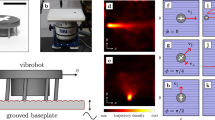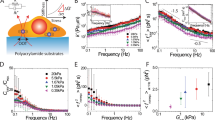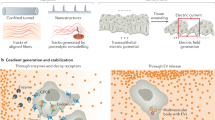Abstract
Many physiological processes depend on the response of biological cells to mechanical forces generated by the contractile activity of the cell or by external stresses. Using a simple theoretical model that includes the forces due to both the mechanosensitivity of cells and the elasticity of the matrix, we predict the dynamics and orientation of cells in both the absence and presence of applied stresses. The model predicts many features observed in measurements of cellular forces and orientation including the increase with time of the cellular forces in the absence of applied stress and the consequent decrease of the force in the presence of quasi-static stresses. We also explain the puzzling observation of parallel alignment of cells for static and quasi-static stresses and of nearly perpendicular alignment for dynamically varying stresses. In addition, we predict the response of the cellular orientation to a sinusoidally varying applied stress as a function of frequency.
This is a preview of subscription content, access via your institution
Access options
Subscribe to this journal
Receive 12 print issues and online access
$209.00 per year
only $17.42 per issue
Buy this article
- Purchase on Springer Link
- Instant access to full article PDF
Prices may be subject to local taxes which are calculated during checkout



Similar content being viewed by others
References
Discher, D. E., Janmey, P. & Wang, Y. Tissue cells feel and respond to the stiffness of their substrate. Science 310, 1139–1143 (2005).
Engler, A. J., Sen, S., Sweeney, H. L. & Discher, D. E. Matrix elasticity directs stem cell lineage specification. Cell 126, 677–689 (2006).
Jakab, K., Neagu, A., Mironov, V., Markwald, R. R. & Forgacs, G. Engineering biological structures of prescribed shape using self-assembling multicellular systems. Proc. Natl Acad. Sci. 101, 2864–2869 (2004).
Huang, S. & Ingber, D. E. The structural and mechanical complexity of cell-growth control. Nature Cell Biol. 1, E131–E138 (1999).
Korff, T. & Augustin, H. G. Tensional forces in fibrillar extracellular matrices control directional capillary sprouting. J. Cell Sci. 112, 3249–3258 (1999).
Bershadsky, A. D., Balaban, N. Q. & Geiger, B. Adhesion-dependent cell mechanosensitivity. Annu. Rev. Cell Dev. Biol. 19, 677–695 (2003).
Brown, R. A., Prajapati, R., McGrouther, D. A., Yannas, I. V. & Eastwood, M. Tensional homeostasis in dermal fibroblasts: mechanical responses to mechanical loading in three dimensional substrate. J. Cell. Physiol. 175, 323–332 (1998).
Lo, C. M., Wang, H. B., Dembo, M. & Wang, Y.-L. Cell Movement is guided by the rigidity of the substrate. Biophys. J. 79, 144–152 (2000).
Yoshigi, M., Hoffman, L. M., Jensen, C. C., Yost, H. J. & Beckerle, M. C. Mechanical force mobilizes zyxin from focal adhesions to actin filaments and regulates cytoskeletal reinforcement. J. Cell Biol. 171, 209–215 (2005).
Shirinsky, V. P. et al. Mechano-chemical control of human endothelium orientation and size. J. Cell Biol. 109, 331–339 (1989).
Hayakaya, K., Sato, N. & Obinata, T. Dynamic reorientation of cultures cells and stress fibers under mechanical stress from periodic stretching. Exp. Cell Res. 268, 104–114 (2001).
Eastwood, M., Mudera, V. C., McGrouther, D. A. & Brown, R. A. Effect of precise mechanical loading on fibroblast populated collagen lattices: Morphological changes. Cell Motil. Cytoskeleton 39, 13–21 (1998).
Collinsworth, A. M. et al. Orientation and length of mammalian skeleton myocytes in response to a unidirectional stretch. Cell Tissue Res. 302, 243–251 (2000).
Takemasa, T., Sugimoto, K. & Yashita, K. Amplitude-dependent stress fiber reorientation in early response to cyclic strain. Exp. Cell Res. 230, 407–410 (1997).
Smith, P. G., Garcia, R. & Kogerman, L. Strain reorganizes focal adhesions and cytoskeleton in cultured airway smooth muscle cells. Exp. Cell Res. 232, 127–136 (1997).
Wang, J. H.-C. & Grood, E. S. The strain magnitude and contact guidance determine orientation response of fibroblasts to cyclic substrate strains. Connect. Tissue Res. 41, 29–36 (2000).
Wang, J. H.-C., Goldschmidt, C. P., Wille, J. & Yin, F. C.-P. Specificity of endothelial cell reorientation in response to cyclic mechanical stretching. J. Biomech. 34, 1563–1572 (2001).
Neidlinger-Wilke, C., Grood, E., Claes, L. & Brand, R. Fibroblast orientation to stretch begins within three hours. J. Orthopaedic Res. 20, 953–956 (2002).
Cha, J. M., Park, S.-N., Noh, S. H. & Suh, H. Time-dependent modulation of alignment and differentiation of smooth muscle cells seeded on a porous substrate undergoing cyclic mechanical strain. Artif. Organs 30, 250–258 (2006).
Kurpunski, K. et al. Anisotropic mechanosensing by mesenchymal stem cells. Proc. Natl Acad. Sci. 103, 16095–16100 (2006).
Schwarz, U. S. & Safran, S. A. Elastic interactions of cells. Phys. Rev. Lett. 88, 48102–48105 (2002).
Bischofs, I. B., Safran, S. A. & Schwarz, U. S. Elastic interactions of active cells with soft materials. Phys. Rev. E 69, 21911–21927 (2004).
Dembo, M. & Wang, Y.-L. Stresses at the cell-to-substrate interface during locomotion of fibroblasts. Biophys. J. 76, 2307–2316 (1999).
Oliver, T., Dembo, M. & Jacobson, K. Separation of propulsive and adhesive stresses in locomoting keratocytes. J. Cell Biol. 145, 589–604 (1999).
Balaban, N. Q. et al. Force and focal adhesion assembly: A close relationship studied using elastic micropatterned substrates. Nature Cell Biol. 3, 466–472 (2001).
Zemel, A., Bischofs, I. B. & Safran, S. A. Active elasticity of gels with contractile cells. Phys. Rev. Lett. 97, 128103–128106 (2006).
Saez, A., Buguin, A., Silberzan, P. & Ladoux, B. Is the mechanical activity of epithelial cells controlled by deformations or forces? Biophys. J. 89, L52–L54 (2005).
Landau, L. D. & Lifshitz, E. M. Theory of Elasticity (Pergamon, Oxford, 1986).
Safran, S. A., Gov, N., Nicolas, A., Schwarz, U. S. & Tlusty, T. Physics of cell elasticity, shape and adhesion. Physica A 352, 171–201 (2005).
Chaikin, P. M. & Lubensky, T. C. Principles of Condensed Matter Physics (Cambridge Univ. Press, Cambridge, 1995).
Nicolas, A. & Safran, S. A. Limitation of cell adhesion by the elasticity of the ECM. Biophys. J. 91, 61–73 (2006).
Acknowledgements
We are grateful for discussions with A. Buguin, M. E. Fisher, N. Gov, S. Jungbauer, R. Kemkemer, B. Ladoux, A. Nicolas, J. Prost, U. Schwarz and P. Silberzan and for support from the Israel Science Foundation and an EU Network Grant. This research was made possible in part by the historic generosity of the Harold Perlman Family.
Author information
Authors and Affiliations
Corresponding author
Ethics declarations
Competing interests
The authors declare no competing financial interests.
Rights and permissions
About this article
Cite this article
De, R., Zemel, A. & Safran, S. Dynamics of cell orientation. Nature Phys 3, 655–659 (2007). https://doi.org/10.1038/nphys680
Received:
Accepted:
Published:
Issue Date:
DOI: https://doi.org/10.1038/nphys680
This article is cited by
-
A Statistical Mechanics Approach to Describe Cell Reorientation Under Stretch
Bulletin of Mathematical Biology (2023)
-
Stress fiber growth and remodeling determines cellular morphomechanics under uniaxial cyclic stretch
Biomechanics and Modeling in Mechanobiology (2022)
-
Interfacial friction and substrate deformation mediate long-range signal propagation in tissues
Biomechanics and Modeling in Mechanobiology (2022)
-
A nonlinear elastic description of cell preferential orientations over a stretched substrate
Biomechanics and Modeling in Mechanobiology (2021)
-
What factors determine the number of nonmuscle myosin II in the sarcomeric unit of stress fibers?
Biomechanics and Modeling in Mechanobiology (2021)



